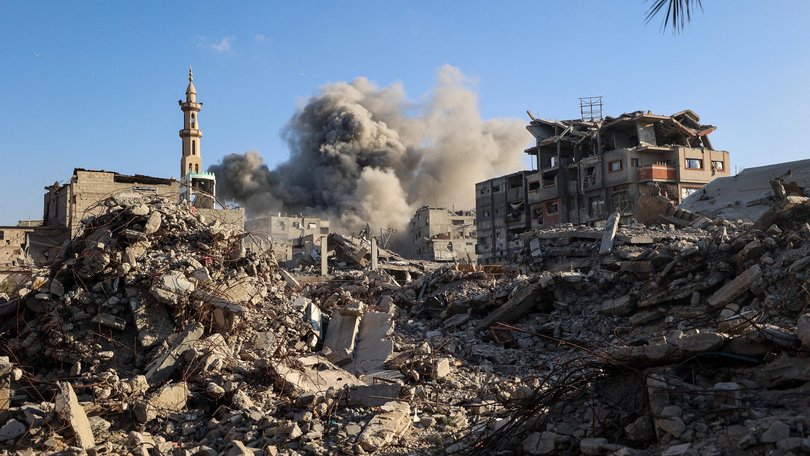Israel strikes Gaza and temporarily halts aid, saying Hamas broke truce

Israel on Sunday launched its heaviest wave of attacks on the Gaza Strip since a fragile ceasefire took hold a week ago and said it had temporarily suspended humanitarian aid after accusing Hamas of violating the truce by firing on its soldiers, killing two.
After nightfall, the Israeli military said in a statement that it had “begun the renewed enforcement of the ceasefire” after carrying out a series of significant strikes against Hamas targets and in accordance with a directive from the government.
The deadly flare-up of violence Sunday and the temporary suspension of aid were the most serious tests yet of the ceasefire, which was negotiated under heavy pressure by the Trump administration and signed with great fanfare by President Donald Trump.
Sign up to The Nightly's newsletters.
Get the first look at the digital newspaper, curated daily stories and breaking headlines delivered to your inbox.
By continuing you agree to our Terms and Privacy Policy.The aid was halted because of the intensity of the Israeli strikes, and was expected to resume once the bombing was over, according to an Israeli official, who spoke on the condition of anonymity to discuss a sensitive matter. Israeli officials had initially said that humanitarian aid would be suspended until further notice but later appeared to step back from that decision.
Israel said two of its soldiers were killed early Sunday when Palestinian militants attacked forces who were operating in an area where the Israeli military is allowed to be under the ceasefire agreement. The deaths prompted a strong response.
Gaza’s health officials reported 44 Palestinian deaths across the territory Sunday.
Both Israel and Hamas have now accused each other of violating the truce after repeated flare-ups of violence over the past three days. But both sides made clear Sunday that they were still committed to maintaining the truce.
The Israeli military said the Palestinian fighters had fired an anti-tank missile at its troops and then shot at them in the Rafah area of southern Gaza that remains under Israeli control.
The military called this “a blatant violation” of the truce. In response, the military said, Israeli forces struck in the area “to eliminate the threat” and dismantle tunnel shafts and other military structures.
On Sunday afternoon, the military intensified its attacks, saying it struck dozens of Hamas targets throughout Gaza. Israeli forces also struck a group of people they identified as armed militants crossing the ceasefire line in northern Gaza, the military said in a statement.
Prime Minister Benjamin Netanyahu of Israel blamed Hamas for the latest violence. He said he had consulted with his defense minister and security chiefs and had instructed them to act forcefully against militant targets in Gaza.
Hamas’ military wing said in a statement that it was “unaware of any events or clashes taking place in the Rafah area,” saying they had lost contact with their fighters there months ago.
Hamas said in a statement that a delegation of its leaders had arrived in Cairo on Sunday to follow up on the implementation of the ceasefire agreement with mediators and other Palestinian groups. A Hamas official, Izzat al-Rishq, in a separate statement Sunday accused Israel of continuing to violate the truce and of fabricating “flimsy pretexts” to justify its attacks.
On Friday, the Israeli military fired on a vehicle in northern Gaza, killing at least nine people, including four children, according to a Gaza rescue service that is part of the territory’s Hamas-run Interior Ministry.
In relation to that episode, the Israeli military said the vehicle had crossed over a demarcation line where Israel’s forces have withdrawn to under the terms of the ceasefire. The military added that its forces had fired on the vehicle, which it described as “suspicious,” after the vehicle ignored warning shots.
The Israeli military has repeatedly warned civilians not to cross the new lines or approach its troops in the Israeli-held areas but many Palestinians — either lacking internet, puzzling over unclear maps, or simply lost in the devastated enclave — have at times been unsure about whether they have entered a restricted area.
The ceasefire deal had provided for a significant increase in humanitarian aid. The number of trucks entering Gaza was supposed to have doubled to 600 a day from about 300.
The enclave has been gripped by widespread hunger in recent months. Most of its population of about 2 million people have been displaced multiple times. Many lack shelter, with whole neighbourhoods flattened by Israeli forces and many of the buildings elsewhere in Gaza now damaged or destroyed.
After Sunday’s violence, members of Mr Netanyahu’s hard-line government immediately called for a full resumption of Israel’s offensive against Hamas, the militant group that led the October 7, 2023, attack against Israel that set off the war.
Itamar Ben-Gvir, the ultranationalist minister of national security, called for a resumption of fighting “at full strength.” Any notions that Hamas would abide by the ceasefire agreement, he added, “are predictably proving dangerous to our security.”
Mr Ben-Gvir was among the far-right ministers opposed to the ceasefire in the first place, believing that Israel should have continued fighting until Hamas was fully defeated.
Israel still controls about half the territory in Gaza and has accused Hamas fighters of operating out of tunnels beneath areas still under Israeli control.
Israeli officials have also expressed frustration over the slow pace at which Hamas has been handing over the remains of deceased captives as part of the ceasefire deal.
Hamas has freed the last 20 living Israeli hostages and turned over the bodies of 12 captives over the past week, according to the Israeli government. A 13th body that Hamas handed over to Israel was found by forensic experts not to match any of the captives.
Israel has freed almost 2,000 Palestinian prisoners and sent the bodies of more than 100 Palestinians to Gaza.
Israel identified two dead hostages whose bodies were handed over late Saturday as Ronen Engel, 54, and Sonthaya Oakkharasri, 30, a Thai citizen who had been working in agriculture in Be’eri, a border community.
Engel was killed in Nir Oz, another Israeli border community ravaged during the Hamas-led attack on Israel in 2023. His body was taken to Gaza.
The bodies of 16 other captives still remain in Gaza, according to the Israeli government.
Hamas has said repeatedly that it will be difficult to locate and recover all of them. Some are buried deep under rubble and require heavy equipment to extract them.
This article originally appeared in The New York Times.
© 2025 The New York Times Company
Originally published on The New York Times
